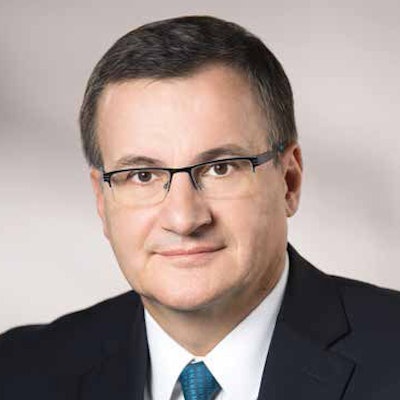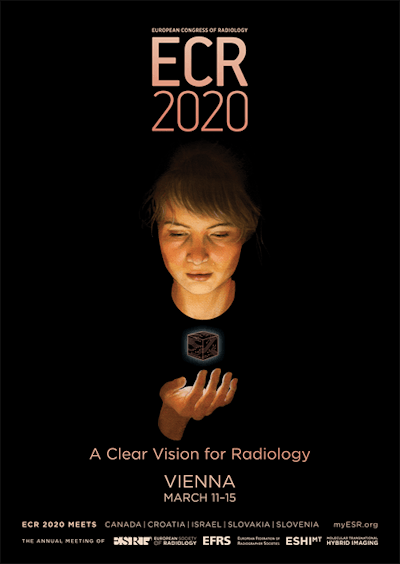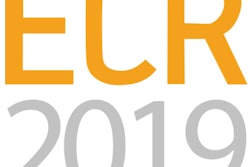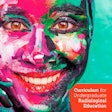
It is a well-established tradition that on the final day of the congress, ECR Today looks ahead to next year's ECR. We, therefore, spoke with Prof. Boris Brkljačić from Zagreb, Croatia, the incoming European Society of Radiology (ESR) president, who is in charge of ECR 2020. He shared with us some of his ideas and plans for the next European Congress of Radiology.
ECR Today: Prof. Brkljačić, the first visual impression of the next congress is always the congress poster. For ECR 2020 you chose artwork by the award-winning Canadian illustrator Peter Diamond, depicting a young woman looking at a small object floating just above her cupped hand. Can you tell us a little about how this particular design came about?
 All images courtesy of the ESR.
All images courtesy of the ESR.Boris Brkljačić: The ESR Office provides several options for the congress poster, created by professional designers, and the congress president and Program Planning Committee members select one. The selected solution was the best among the proposed options. It resembles Rembrandt's artwork, with sharp light and dark contrast, and is in good accordance with the slogan for ECR 2020: "A Clear Vision for Radiology." The small floating object represents artificial intelligence, which will be an important topic at the congress, and the names of the ECR 2020 "ESR meets" countries are visible at the bottom of the poster. The 2020 poster contains fewer colors and illustrations, compared to the 2019 poster, and is concordant with the visual style of the ESR's main scientific publication, the journal European Radiology.
ECRT: As the new ESR president, you are also chairperson of the Program Planning Committee for ECR 2020, which has already been working on preparing the scientific program for a few months. Can you tell us something about the highlights of the 2020 program or any specific focus we can expect?
BB: I am very fortunate to have selected excellent Program Planning Committee members, who are hardworking and dedicated experts in their fields. Planning has already been running at full speed for a few months in order to create a well-balanced program of very high-quality professional, educational, and scientific content. New Horizons Sessions, State of the Art Symposia, and Special Focus Sessions have already been selected and mostly created; they are very relevant and balanced, so that young radiologists and experts in particular radiological fields will have interesting sessions to choose from in all areas of radiology. Emerging and hot topics will be covered, like lung cancer screening, artificial intelligence, stroke diagnosis and treatment, and many others. I expect that the plenary/honorary sessions should be the highlight of the congress, as they are interesting for all participants, regardless of their age and expertise.
ECRT: Your own special areas of interest are breast imaging and interventional radiology; will these interests be reflected in the scientific program?
BB: Breast imaging and interventional radiology will have important places in the program, but I will take special care to create a balanced program, attractive for all participants, so that all areas of radiology will be represented, without preference for special areas of interest.
ECRT: Speaking of interventional radiology, in 2018 the ECR introduced a brand new feature: Interventional Radiology at the Cube, a separate program, offering an immersive, hands-on introduction to IR. That program has already been greatly expanded for ECR 2019. Can we expect it to be back again in 2020?
BB: Absolutely. The Cube was very successful in 2018, it has been expanded a lot for ECR 2019, and it will be kept and refined even more at ECR 2020. Interventional radiology has a great future; it is one of the few areas where radiologists are directly and actively involved in the treatment of patients, so IR has to be well-represented at every ECR. I hope that the Cube will attract many students to go into radiology, and many residents to become involved in interventional radiology.
ECRT: The hot topics of artificial intelligence and machine learning will also be in the spotlight at ECR 2020. Can you give us any hints as to what is planned in terms of the program?
BB: Artificial intelligence and machine learning will be represented substantially, since their importance in radiology is very high and all future congresses will have to contain many AI-related sessions. One of the ECR 2020 Academies will be dedicated to artificial intelligence.
ECRT: The Image Interpretation Quizzes, both the junior and "regular" versions, are highlights at every ECR. Can you tell us anything about what is planned for those next year?
BB: The "regular" version for ECR 2020 will be chaired by the ESR Past President, Prof. Paul M. Parizel, and it is well-known that Paul is an innovative person with many original ideas, so I am sure that participants will enjoy the quiz a lot. The junior quiz will be chaired by a young cardiac radiologist from Slovenia, Maja Pirnat. We are still considering ideas for themes and will pay close attention to the reactions and feedback to the junior quiz at ECR 2019.
 Incoming ESR President Prof. Boris Brkljačić is a professor of radiology and vice dean at University of Zagreb School of Medicine in Zagreb, Croatia, and chair of the department of diagnostic and interventional radiology at University Hospital "Dubrava" in Zagreb.
Incoming ESR President Prof. Boris Brkljačić is a professor of radiology and vice dean at University of Zagreb School of Medicine in Zagreb, Croatia, and chair of the department of diagnostic and interventional radiology at University Hospital "Dubrava" in Zagreb.ECRT: It has been a long-standing ECR tradition to invite some guest countries for the "ESR meets" sessions. Which countries will be featured next year and what can we expect from their presentations?
BB: Canada will be one "ESR meets" country in 2020, for the first time ever. Canada has a very strong and well-organized national radiology society and many excellent radiologists. I am convinced that the program that the Canadian Association of Radiologists will provide will be very interesting for ECR participants, who will have the opportunity to find out more about radiology in Canada and learn more about this huge and beautiful country.
For the second time, after 12 years, Israel will be an "ESR meets" country. Israel has been somewhat underrepresented so far at the ECR; it is a land of scientific innovations, sometimes referred to as the start-up nation, and many things that we use in everyday radiological and medical practice were invented in Israel. It has a very active and well-organized radiology association that has already created a very attractive program. Both Canadian and Israeli presentations will deal with innovations, technology, and artificial intelligence.
My home country, Croatia, was already an ESR meets country in 2009. I have therefore decided to present two smaller, neighboring Slavic countries, Slovenia and Slovakia, which have not yet been "meets countries," together in a single session with Croatia. These three countries have many similarities in terms of their medical systems, the practice of radiology, and their history in general. The presentations from Slovakia, Slovenia, and Croatia will deal with cardiovascular and interventional radiology and interventional neuroradiology.
ECRT: The ECR program has become increasingly diverse in recent years, with more and more sessions aimed at radiographers, nuclear physicians, and other specific groups. In fact, the ECR is now not only the annual meeting of the European Society of Radiology, but also of the European Federation of Radiographer Societies and the European Society for Hybrid, Molecular and Translational Imaging. Has the ESR noticed corresponding changes in attendance figures for participants from those fields?
BB: I am very happy to say that over recent years, the radiographers' program has grown considerably, as has the participation of radiographers. A total of 2,177 radiographers and radiography students, from 75 countries, attended ECR 2018 and preregistration figures for ECR 2019 looked amazing, with an expected increase in radiographers' attendance of about 20%. The ECR has now become one of the largest international gatherings of radiographers, and I look forward to receiving final attendance numbers.
A similar success can be announced for medical physicists and nuclear medicine physicians; their numbers are also growing continuously, and I am very glad that the ESR has managed to involve important partners more and more, and that they are increasingly feeling at home at the ECR.
ECRT: Will there be any particular focal points in the 2020 scientific program for radiographers, nuclear physicians, physicists, and maybe other target groups?
BB: The part of the program already created contains dedicated special focus sessions for radiographers, physicists, and hybrid imaging physicians, and professional sessions will also deal with these fields. I am also sure that the joint ESR-RSNA session on all aspects of diagnosis, treatment, and follow-up of patients with stroke will be very attractive for participants, and of very high quality.
Of course, there will again be a great number of joint sessions with various partner societies, but these are still being negotiated.
ECRT: The ECR has a worldwide reputation for tackling new challenges and always being open to novel ideas. Are there any innovations already in the pipeline for ECR 2020?
BB: The ECR Program Planning Committee is trying hard to represent all relevant novelties in radiology, and the program is open for last-minute changes in case some hot topic emerges. We will try to present the new challenges, especially in New Horizons Sessions, but also in other parts of the program. I plan to attract many participants to the noon plenary sessions, as their format will be changed considerably in 2020; the lectures will be given by nonradiologists, and will be very relevant, generally, for all ECR participants.
ECRT: You are the first ESR president from Croatia. Will your background be reflected at the congress or the accompanying social events?
BB: Croatia will be represented in the "ESR meets" session together with Slovenia and Slovakia. An excellent team of Croatian interventional neuroradiologists will present very good results from a long-running study. Several good speakers will have opportunities to participate in the educational program. I will also take care that good speakers from some other countries who have not yet been greatly involved at the ECR will get a chance to present. In the social program I do plan to invite some excellent Croatian musicians.
ECRT: As ESR president, your most obvious focus for the next 12 months will be ECR 2020, but you will also have numerous other responsibilities. Can you tell us a little about your official duties for the year?
BB: In addition to planning ECR 2020, I will represent the ESR at many national congresses and international meetings. In addition to professional talks, I will present the ESR's various activities. I think that this is very important, so that European and non-European radiologists are well-informed about various ESR activities and the benefits of ESR membership. Of course, it is impossible for the ESR president to visit all national meetings, since there is considerable overlap between many of them. But other members of the ESR Board and Executive Council will also represent the ESR at many national meetings. For 2019, my schedule is almost full, and I will have very few free weekends, if any.
ECRT: To finish on a personal note, what made you choose radiology over any other medical specialty and how would you "sell" radiology to medical students?
BB: After graduating from the medical faculty, it was impossible to apply for any residency in Croatia without two years of work, either in general practice or in research at some university department. I was working in research and I simultaneously enrolled in an ultrasound postgraduate course, in English, mostly with gynecologists. When the radiology residency position opened, I was attracted because I had already acquired some knowledge of ultrasound, and I never regretted the decision, even though initially I planned to go into internal medicine. Thirty years ago, radiology was not as attractive as it is now, but this changed long ago.
The best way to attract medical students to radiology is to show them the diversity, dynamic nature, and clinical relevance of the profession as much as possible while they are on rotations in our departments as medical students. Many students fall in love with radiology in this period of their education. In Croatia we fortunately have more applicants for radiology than for many surgical residencies and the quality of young doctors who apply for radiology residency is quite high, which is very important for the future of our specialty.
Originally published in ECR Today on 3 March 2019.
Copyright © 2019 European Society of Radiology



















